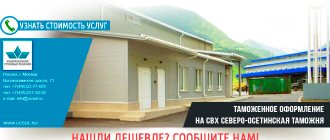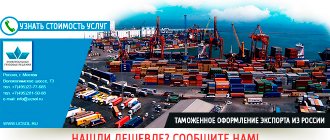HomeCustoms clearance of Cars
Customs clearance of a car is a mandatory procedure for all cars transported across the customs border of the Russian Federation. This is a very relevant topic for those who are planning to purchase a vehicle abroad. Knowledge of the basic rules of customs clearance will also not hurt those who prefer to buy foreign cars.
The procedure consists of several stages of customs clearance of cars for individuals:
The first stage is filling out a customs declaration when registering a car.
When filling out the customs declaration, only reliable information must be entered. The document must have a registration number, which will subsequently be entered into the database. The declaration requires information about the owner of the car, which includes address, passport data, etc., data about the imported car and information necessary for preferential registration of the vehicle. When providing the latter, you must indicate the date of issue and the number of the attached document.
The second stage is the provision of additional documents for the car.
Having filled out the declaration and other necessary documents, you must hand them over to the inspector, who will study them.
The third stage is passing customs inspection of your car.
The inspector examines the information specified in the declaration and the presence of all necessary documents. The following are considered mandatory for customs clearance of vehicles:
- Vehicle technical documents
- Indication of the purpose of importing a car (checking whether duty benefits are provided)
- Vehicle mileage on the day of inspection
The fourth stage is when customs makes a decision regarding your car.
Having examined the submitted documents, the customs inspector may accept them for further work or, if necessary, ask for additional documents, which are also necessary for customs clearance (customs clearance of cars) and control.
The fifth stage is going through the vehicle inspection procedure.
A customs inspector, in the presence of the vehicle owner, inspects the vehicle at a specially equipped site, during which the information specified in the declaration is checked for accuracy.
If a violation of customs rules is detected or if there are sufficient grounds to doubt the authenticity of the submitted documents, the inspector draws up a protocol on the identified violations of customs rules, and the car is placed in a temporary storage warehouse.
If no violations are revealed during the inspection, the inspector, having checked the correctness of filling out all the fields of the customs declaration, makes an entry in it - “Checked”, which is secured with a signature indicating the full name, and a personal seal, and the date of execution of the document is also indicated.
Based on the presented package of documents, an inventory is drawn up in two copies, which, together with the documents, is transferred to the customs clearance (CT) and currency control (VC) department, where the customs value of the vehicle that was declared is checked, and additional expenses incurred by the owner are also studied when driving a car to the customs border of the Russian Federation. Each copy of the inventory is certified by the signatures of the VC and TTS inspectors who accepted the document, and is also dated. Upon completion of this procedure, the documents go to the customs payments department (CPD), where customs payments for the car are calculated, after which the column “Customs payments” is filled in the declaration.
Having calculated the total amount, the inspector puts a personal stamp, signature, enters the full name, and indicating the date of inspection, transfers all documents according to the inventory to the car registration department.
After which the customs documents are filled out, a customs receipt order is issued, which is necessary for paying customs duties during customs clearance of passenger cars. Payments themselves are accepted.
Data about the imported vehicle and its owner are entered into the computer.
At the same time the following check is performed:
- Have any vehicles been previously registered in the name of a person declaring the import of a car into the territory of the Russian Federation on a preferential basis?
- The number of cars imported by an individual into the territory of the Russian Federation during one calendar year.
- Is the car wanted by the traffic police or Interpol?
Upon completion of the procedure, a vehicle import certificate is filled out in 2 copies. One of the copies remains at customs, which complies with the rules for storing strict reporting documents, the second is issued to the owner. The certificate is affixed with the official seal of the customs authority and the personal seal and signature of the inspector to whom the document was issued. After that, the number and date of registration are entered into the customs declaration.
Customs clearance of the vehicle is completed by filling out a vehicle passport (PTS).
How to submit a GDT
Customs declaration of cargo and submission of a declaration is one of the most important stages required for the movement of goods across the border of the Customs Union. Correct completion of all fields and items of the declaration ensures unhindered import of cargo into Russia.
Submitting a declaration to customs for legal entities and individual entrepreneurs must be done electronically via the Internet. In accordance with the legislation of the Russian Federation, declarations are certified by an electronic digital signature (EDS) of the client or customs broker (customs representative). Filling out and submitting a declaration to the customs authorities is called a customs declaration. The customs declaration for goods was formerly called the “Cargo Customs Declaration” or “CCD”.
Separately, it is worth mentioning that the period for registration of the declaration by the customs authority from the moment of submission is 2 hours. Release of goods by legal entities - no more than 24 hours.
Registration requirements for the customs declaration for a car
When filling out a customs declaration form, it is worth considering the following rules:
- The form must be approved by law. Printing the form on a PC yourself will not work. The form must be requested from the customs service.
- The issued declaration form must be completed by hand.
- The language in which data can be entered is Russian or English.
- To enter additional information, the applicant must enter it on the other side of the form or on an additional sheet, and then have it certified by an official. The customs inspector must put his personal stamp, with an individual number, and signature.
- Information should be entered in capital letters.
- The form should not contain errors, corrections or blots.
- Correction is possible, but with the consent of the official. He must certify the changes when crossing out and labeling data.
- Foreign initials are allowed to be written in Latin letters.
- Vehicle license plate numbers can be entered in the original format, as they are. For example, using Latin letters.
- The declaration must be completed in two copies. One remains with the owner of the vehicle, the other is sent to the archives of the customs service.
Is it possible to drive a non-customs cleared car in Russia, and how to do it legally and legally?
List of cargoes we handle
- Food;
- Common consumption goods;
- industrial goods and equipment;
- dangerous goods;
- large cargo.
We process cargo in the main customs regimes: import, export and customs transit. It is also possible to place goods under the customs procedure: re-export, re-import, temporary import, temporary export, obtaining a class decision and others.
When importing goods into the customs territory of Russia, there is the possibility of temporary storage.
The procedure for filling out a customs declaration for a vehicle
Enter information on the form in this order:
- Paragraph 1 . Place a cross in the appropriate box.
- Point 2. Do not enter anything. This information will be entered by the customs inspector.
- Point 3. Provide information about the car or other vehicle.
- Point 4. Write down the initials of the citizen who will drive the car while he is on the territory of the Russian Federation. This could be the owner of the car, or a representative, or the crew. There must be documents confirming the right to drive the vehicle.
- Point 5. Write the name of the point and country you are entering. For example, “Moscow, Russia”.
- Clause 6. If not only the driver, but also the crew travels on the transport, then their number should be indicated.
- Point 7. The presence or absence of passengers should be confirmed with a cross in the appropriate box. Nearby, you can indicate the number of passengers.
- Point 8. Place a cross to confirm the presence or absence of supplies.
- Clause 9. If you are transporting goods or any products, you should indicate them.
- Clause 10. In the case of transportation of spare parts or equipment, their presence or absence should be indicated, as well as their names.
- Clause 11. In this section you should indicate that you are starting the international transportation of passengers and baggage outside the customs territory. When the vehicle is removed, the completion of transportation is marked.
- Clause 12. Other information can be entered in this section.
- Item 13. This is where you should sign and date.
Other information must be provided by the customs inspector.
Features of DT design
The Federal Customs Service of the Russian Federation is globally improving, automating and simplifying the preparation and completion of declarations. The first step was the abolition of paper submission of DT and the opening of electronic declaration centers. The next step will be the centralization of all electronic declarations on a single declaration server, from where they will be distributed automatically to the EDC and customs posts according to predetermined distribution conditions.
Powers will be distributed between customs: electronic customs will be assigned the execution of procedures such as export, import and free customs zone. Customs offices of actual control will deal with issues related to actual control: opening/closing of transit procedures, document verification, inspection/inspection of goods and vehicles, registration of other procedures, etc. In addition, there will be a shift in the emphasis of customs control to post-release control.
Thereby, the number of EDCs will be reduced and the registration of DT will be fully automated and independent.
Taxes and duties of the batch that is declared must be paid in full in order to obtain the right to sell on the domestic market.
Filling out the customs declaration of imported goods is regulated by the Customs Code of the EAEU, as well as the Federal Law “On Customs Regulation in the Russian Federation”.
Results
Legal entities in whose name the vehicles are registered are required to submit a transport tax return to the tax authorities. Deadline: no later than February 1 of the year following the tax period. But in 2021, February 1 is a Saturday, so the deadline is moved to working Monday 02/03/2020.
For the report for 2021, use the declaration form approved by order of the Ministry of Finance of Russia dated December 5, 2016 No. ММВ-7-21/ [email protected] (as amended by the order of the Federal Tax Service dated November 26, 2018 No. ММВ-7-21/ [email protected] ) .
Sources:
- tax code of the Russian Federation
- Order of the Ministry of Finance of Russia dated December 5, 2016 No. ММВ-7-21/ [email protected]
You can find more complete information on the topic in ConsultantPlus. Free trial access to the system for 2 days.
Timing and cost
Our company provides comprehensive support to the client and, in addition to filing a customs declaration, provides the following services:
- allocation of a specific customs clearance specialist for supplies under a foreign trade contract, consulting on all customs issues
- preliminary review and approval of customs transport and shipping documents
- recommendations on HS codes for goods
- preliminary calculation of customs value and amount of advance customs payments
- registration of the Customer at customs (if necessary)
- document flow with the place of registration
- drafting DT and related documents
- information and consulting services as part of the delivery
- organization of customs clearance
- provision of information according to the requirements of customs authorities
- representation of the Customer's interests in the customs authorities of the Russian Federation
- organization, if necessary, of preliminary customs inspection of goods and vehicles before submitting the DT
- preparation and execution of TD under the seal of the customs representative
- control of write-off of customs duties and customs clearance fees
- and other services depending on the place and mode of customs clearance. For example, receiving a vehicle and processing cargo at a temporary storage warehouse.
| Type of work | Prices (excl. VAT) |
| Carrying out operations at customs and declaring goods for one batch in IM 40 mode: | from 5,000 rubles |
| Carrying out operations at customs and declaring, in relation to each subsequent consignment of goods in the import mode, if there are several consignments of goods in one vehicle (IM 40): | from 4,000 rubles |
| Registration of each additional sheet of DT, starting from the 5th (fifth) product in IM 40 mode: | from 450 rubles |
| Conducting customs operations and declaring goods of one consignment in export mode (EC 10): | from 3,000 rubles |
| Carrying out customs operations and customs clearance for goods of the same consignment (other regimes): | from 10,000 rubles |
| Payment (additional payment) of any types of customs duties under one customs declaration on behalf and on behalf of the Customer, during customs declaration of the Customer’s goods, using the Customs Representative’s own funds through terminal payment using a customs card/online service of the ROUND payment system. | from 3% of the documented payment amount (additional payment), but not less than 1,000 rubles |
| Assistance in obtaining a Declaration of Conformity with the CU TR for goods, as well as other permitting documents for customs. | discussed individually |
The cost of customs clearance services for diesel cargo in TAISU-TB is optimal and is calculated on an individual basis. The deadline for issuing a customs declaration (CD) is within 1 day.
The TAISU-TB company provides a full range of services for registration of TD and customs clearance of imported cargo. Our branches are located throughout the country from Vladivostok to Kaliningrad, and our specialists have extensive experience and are ready to take on all issues regarding the declaration and import of goods. For each client we assign a personal specialist.
Customs declaration
Goods are subject to customs declaration when they are placed under a customs procedure or goods for personal use subject to customs declaration, supplies and vehicles for international transportation (in cases determined by Chapter 38 of the Customs Code of the Eurasian Economic Union) without being placed under a customs procedure.
Customs declaration is carried out in electronic form.
Customs declaration in writing is allowed:
1) when placing goods under the customs procedure of customs transit;
2) in relation to goods for personal use;
3) in relation to goods sent by international mail;
4) in relation to vehicles of international transport;
5) when used as a customs declaration of transport (transportation), commercial and (or) other documents, including those provided for in international treaties of the Member States with a third party;
6) in other cases determined by the Commission and the legislation of the Member States on customs regulation in cases provided for by the Commission.
Regardless of the above cases, a customs declaration in writing can be carried out if the customs authority does not have the opportunity to ensure that the declarant carries out the customs declaration in electronic form due to a malfunction of the information systems used by the customs authorities caused by technical failures, disruptions in the operation of communications (telecommunication networks) and the Internet), power outages, as well as in other cases established by the legislation of the Member States.
Types of customs declaration:
1. The declaration for goods is used when placing goods under customs procedures (with the exception of the customs procedure for customs transit) and in some cases when customs declaring supplies (Decision of the Customs Union Commission dated May 20, 2010 No. 257).
As a declaration for goods, it is allowed to use transport (transportation), commercial and (or) other documents, including those provided for in international treaties of the Member States with a third party, containing information necessary for the release of goods, in cases and in the manner determined by the Customs Code of the Eurasian economic union (hereinafter referred to as the Union), international treaties of the member states with a third party and (or) the Commission and the legislation of the member states in cases provided for by the Commission (Decision of the Customs Union Commission dated 20.05.2010 No. 263, Decision of the Board of the Eurasian Economic Commission dated 25.12 .2012 No. 290).
When customs declaring goods sent in international mail, in accordance with the customs procedure for release for domestic consumption, documents provided for by the acts of the Universal Postal Union and accompanying international mail may be used as a declaration for goods in the following cases:
1) customs duties and taxes are not subject to payment in respect of such goods;
2) prohibitions and restrictions are not established in relation to such goods, and measures to protect the domestic market are not applied.
When customs declaring goods sent in international mail, in accordance with the customs procedure for export, as well as in accordance with the customs procedure for re-import, goods exported from the customs territory of the Union in international mail and not delivered to recipients can be used as a declaration for goods documents provided for by the acts of the Universal Postal Union and accompanying international postal items, in cases and conditions established by the legislation of the member states.
2. The transit declaration is used when placing goods under the customs procedure of customs transit (Decision of the Customs Union Commission dated June 18, 2010 No. 289).
As a transit declaration, it is allowed to use transport (transportation), commercial and (or) other documents, including those provided for in international treaties of the Member States with a third party, containing information necessary for the release of goods, in cases and in the manner determined by the Customs Code of the Union, international treaties of the Member States with a third party and (or) the Commission and the legislation of the Member States in cases provided for by the Commission.
3. The passenger customs declaration is used for customs declaration of goods for personal use, and when placing goods for personal use under the customs procedure of customs transit (Decision of the Customs Union Commission dated June 18, 2010 No. 287).
When customs declaring goods sent in international mail, documents provided for by the acts of the Universal Postal Union and accompanying international mail can be used as a passenger customs declaration.
4. The vehicle declaration is used for customs declaration of vehicles for international transportation and in some cases for customs declaration of supplies (Decision of the Customs Union Commission dated October 14, 2010 No. 422).
The carrier's standard documents provided for in the international agreements of the Member States with third parties in the field of transport can be used as a declaration for the vehicle.
As a declaration for a vehicle, it is permitted to use preliminary information presented in the form of an electronic document in the manner determined by the Commission.
Customs procedures
Depending on the purposes of location and use of goods in the customs territory of the Union, their export from the customs territory of the Union and (or) location and use outside the customs territory of the Union, the following customs procedures are applied:
| Release for domestic consumption | customs procedure applied in relation to foreign goods, according to which goods are located and used in the customs territory of the Union without restrictions on possession, use and (or) disposal of them provided for by international treaties and acts in the field of customs regulation in relation to foreign goods, if otherwise not established by the Customs Code of the Union |
| Export | customs procedure applied to goods of the Union, according to which such goods are exported from the customs territory of the Union for permanent residence outside its borders |
| Customs transit | customs procedure, according to which goods are transported (transported) from the customs authority of departure to the customs authority of destination without paying customs duties, taxes, special, anti-dumping, countervailing duties, subject to the conditions for placing goods under this customs procedure |
| Customs warehouse | customs procedure applied to foreign goods, according to which such goods are stored in a customs warehouse without paying import customs duties, taxes, special, anti-dumping, countervailing duties, subject to the conditions for placing the goods under this customs procedure and their use in accordance with such customs procedures. At the same time, the Commission has the right to determine the list of goods in respect of which the customs procedure of a customs warehouse is not applied (Decision of the Commission of the Customs Union dated September 20, 2010 No. 375). |
| Processing in customs territory | customs procedure applied in relation to foreign goods, according to which processing operations are carried out with such goods on the customs territory of the Union in order to obtain products of their processing intended for subsequent export from the customs territory of the Union, without paying import customs duties in relation to such foreign goods duties, taxes, special, anti-dumping, countervailing duties, subject to the conditions for placing goods under this customs procedure and their use in accordance with such a customs procedure. At the same time, the Commission has the right to determine the list of goods for which the customs procedure for processing in the customs territory is not applied (Decision of the Commission of the Customs Union dated September 20, 2010 No. 375). |
| Processing outside the customs territory | customs procedure applied to goods of the Union, according to which such goods are exported from the customs territory of the Union in order to obtain, as a result of processing operations outside the customs territory of the Union, products of their processing intended for subsequent import into the customs territory of the Union, without paying in relation to such goods of the Union of export customs duties, subject to the conditions for placing the goods under this customs procedure and their use in accordance with such a customs procedure. At the same time, the Commission has the right to determine the list of goods for which the customs procedure for processing outside the customs territory is not applied (Decision of the Commission of the Customs Union dated September 20, 2010 No. 375). |
| Processing for domestic consumption | customs procedure applied to foreign goods, according to which processing operations are carried out with such goods for domestic consumption in order to obtain products of their processing intended for subsequent placement under the customs procedure of release for domestic consumption, without payment in relation to such foreign goods import customs duties, subject to the conditions for placing goods under this customs procedure and their use in accordance with such customs procedure. At the same time, the customs procedure for processing for domestic consumption is applied to goods, the list of which is established by the legislation of the Member States. |
| Free customs zone | customs procedure applied to foreign goods and goods of the Union, according to which such goods are placed and used within the territory of the FEZ or part thereof without paying customs duties, taxes, special, anti-dumping, countervailing duties, subject to the conditions for placing goods under this customs procedure and their use in accordance with such customs procedure. In this case, the Commission has the right to determine the list of goods and (or) categories of goods that are not subject to placement under the customs procedure of a free customs zone. In accordance with the legislation of the Member States, a list of goods and (or) categories of goods that are not subject to placement under the customs procedure of a free customs zone in SEZs created (being created) in the territories of these states may be established. |
| Free warehouse | customs procedure applied to foreign goods and goods of the Union, according to which such goods are placed and used in a free warehouse without paying customs duties, taxes, special, anti-dumping, countervailing duties, subject to the conditions for placing goods under this customs procedure and their use in accordance with such customs procedure. In this case, the Commission has the right to determine the list of goods and (or) categories of goods in respect of which the customs procedure of a free warehouse is not applied. |
| Temporary import (admission) | a customs procedure applied to foreign goods, according to which such goods are temporarily located and used in the customs territory of the Union, subject to the conditions for placing the goods under this customs procedure and their use in accordance with such a customs procedure, with partial payment of import customs duties, taxes and without paying special, anti-dumping, countervailing duties or without paying import customs duties, taxes and without paying special, anti-dumping, countervailing duties. At the same time, categories of goods whose temporary presence and use in the customs territory of the Union in accordance with the customs procedure for temporary import (admission) are allowed without paying import customs duties, taxes, the conditions for such temporary stay and use, as well as the deadlines for such temporary stay and use are determined by the Commission and (or) international treaties of the member states with a third party (Decision of the Customs Union Commission dated 20.09. 2010 No. 375, Decision of the Customs Union Commission dated June 18, 2010 No. 331). |
| Temporary removal | customs procedure applied to goods of the Union, according to which such goods are exported from the customs territory of the Union for their temporary stay and use outside it without paying export customs duties, subject to the conditions for placing the goods under this customs procedure and their use in accordance with such customs procedure. At the same time, the Commission has the right to determine the categories of temporarily exported goods in respect of which their replacement with foreign goods is allowed, as well as cases of such replacement. |
| Re-import | customs procedure applied to foreign goods, according to which such goods, previously exported from the customs territory of the Union, are imported into the customs territory of the Union without paying import customs duties, taxes, special, anti-dumping, countervailing duties, subject to the conditions for placing goods under this customs procedure. Moreover, in relation to certain categories of goods, the Commission has the right to determine the period for placing goods under the customs procedure of re-import, exceeding the period established by the Customs Code of the Union (Decision of the Commission of the Customs Union dated September 20, 2010 No. 375). |
| Re-export | customs procedure applied to foreign goods and goods of the Union, according to which foreign goods are exported from the customs territory of the Union without paying import customs duties, taxes, special, anti-dumping, countervailing duties and (or) with a refund (offset) of the amounts of such duties and taxes, and Union goods - without paying export customs duties, subject to the conditions for placing goods under this customs procedure. |
| Duty free trade | customs procedure applied to foreign goods and goods of the Union, according to which such goods are located and sold at retail in duty-free stores without paying import customs duties, taxes, special, anti-dumping, countervailing duties in relation to foreign goods, subject to the conditions of the premises goods under this customs procedure and their use in accordance with such customs procedure. At the same time, the Commission has the right to determine a list of goods other than those provided for by the Customs Code of the Union, in respect of which the customs procedure for duty-free trade is not applied (Decision of the Commission of the Customs Union dated September 20, 2010 No. 375). |
| Destruction | a customs procedure applied to foreign goods, according to which such goods are destroyed without paying import customs duties, taxes, special, anti-dumping, countervailing duties, subject to the conditions for placing the goods under such a customs procedure. At the same time, the Commission has the right to determine a list of goods other than those provided for by the Customs Code of the Union, in respect of which the customs destruction procedure is not applied. |
| Refusal in favor of the state | customs procedure applied to foreign goods, according to which such goods are transferred free of charge into the ownership (income) of a member state without paying import customs duties, taxes, special, anti-dumping, countervailing duties, subject to the conditions for placing goods under this customs procedure. |
| Special customs procedure | customs procedure applied in relation to certain categories of foreign goods and goods of the Union, according to which such goods are moved across the customs border of the Union, are located and (or) used in the customs territory of the Union or outside its borders without paying customs duties, taxes, special , anti-dumping, countervailing duties, subject to the conditions for placing goods under this customs procedure and (or) their use in accordance with such a customs procedure. At the same time, the Commission has the right to determine other categories of goods in respect of which a special customs procedure is applied, including goods related or not related to these categories of goods, and also determines the conditions for placing goods under a special customs procedure and the procedure for applying the special customs procedure (Decision of the Commission of the Customs Union dated 20.05.2010 No. 329). |
An example of filling out a transport tax return for 2021
Let's look at how to fill out a transport tax return, provided that two vehicles are listed on the balance sheet of Fantasia LLC (TIN 5017123456, KPP 501701001):
- Passenger car Audi A6 Avant quattro (identification number УTH330700M1415145, registration plate - С285МА98, engine power - 249 hp, 2021). Purchased on 08/27/2019.
- A truck with a carrying capacity of more than 12 tons (identification number XTU646008E2441447, brand - KamAZ-6460, registration plate - T182UE50, with an engine power of 400 hp, manufactured in 2011). The car was purchased on July 1, 2016. Registered in the Platon system. In 2021, the fee for compensation for damage to roads is 13,200 rubles.
Fantasia LLC operates in the Moscow region and is the sole owner of both vehicles.
The transport tax rate in 2021 in the Moscow region is:
- 150 rub. for 1 l. With. for the Audi A6 Avant quattro;
- 85 rub. for 1 l. With. for the KamAZ-6460 vehicle.
You can check what transport tax rates are established in your region in the article “Transport tax rates by region - table 2019-2020”.
The Audi A6 Avant quattro is included in the list of expensive cars; a multiplying factor of 1.1 is applied in the calculation.
What to do if the car is expensive, but it is not on the list of the Ministry of Industry and Trade, see here.
The annual amount of transport tax is:
- for the Audi A6 Avant quattro:
249 l. With. × 150 rub./l. With. × 1.1 × 0.3333 = 13,694 rubles,
Where:
1.1 is an increasing factor for expensive cars;
0.3333 is the ownership ratio, defined as the number of complete months of ownership (4 months) divided by the number of months in a year (12).
- for KamAZ vehicle:
400 l. With. × 85 rub./l. With. = 34,000 rub.,
A deduction in the amount of the fee paid for damage caused to roads does not reduce the amount of tax payable.
The total amount of transport tax for 2021 is:
13,694 + 34,000 = 47,694 rubles.
Law of the Moscow Region dated November 16, 2002 No. 129/2002-OZ provides for the payment of advance tax payments.
The down payment for an entire quarter of ownership of the Audi A6 Avant quattro is:
13,694 / 4 = 3,424 rubles.
For the first and second quarters, advance payments are not paid, since the car was purchased only on August 27, 2019.
In the third quarter of 2021, the holding ratio is 0.3333 (Q = 1 month / 3 months). The advance payment, taking into account the ownership coefficient for the third quarter, will be: 3,424 × 0.3333 = 1,141 rubles.
The organization makes advance payments for a KamAZ vehicle in the usual manner. The amount of advances for each quarter was 8,500 rubles. (34,000 / 4 sq.).
See how the transport tax return for 2021 should be filled out in the example considered:
You can also find detailed and line-by-line filling out of the transport tax declaration form that is relevant for 2019 in the article “Procedure for filling out the transport tax declaration”.
Control ratios will help you independently detect errors associated with filling out a transport tax return.
About vehicle declaration
According to paragraph 1 of Art. 350 of the Customs Code, when exporting or importing a vehicle, it is mandatory to fill out and submit a customs declaration for the vehicle.
For members of the Customs Union, TD replace standard carrier documents, the forms of which are provided for by international treaties.
This rule is contained in paragraph 2 of Art. 350 TK . They indicate information about the cargo, the route of the vehicle, its crew, the purpose of crossing the border, spare parts and equipment located in the vehicle.
A detailed list of required documents and information to be provided is specified in paragraph 1 of Art. 159 TK.
These include:
- vehicle document;
- transport documents;
- documents for postal items;
- commercial documents for cargo;
- information: on state registration of vehicles for international transport; about the full name and legal address of the carrier; about the sending country and the receiving country; about the full name of the recipient and sender, their legal addresses; about the number of places that the cargo occupies, labeling and types of packaging of the goods; on the name, codes of goods (according to the Harmonized System or the Commodity Nomenclature of Foreign Economic Activity, at least 4 first digits); about gross weight (kg) or volume (m3); about goods the import of which is prohibited or restrictions are imposed; on the international consignment note.
If the carrier does not have enough standard documents to complete all operations, then it becomes necessary to fill out a TD. In this case, all the papers specified above are attached to the TD.
According to paragraph 5 of Art. 350 TC, after checking the TD, a customs specialist gives permission to import or export a vehicle for international transportation. For this purpose, special marks are made on the declaration.
The instructions on the procedure for performing individual customs operations (Instruction No. 511) contain complete information about the operations and information required to be provided by the international carrier.








